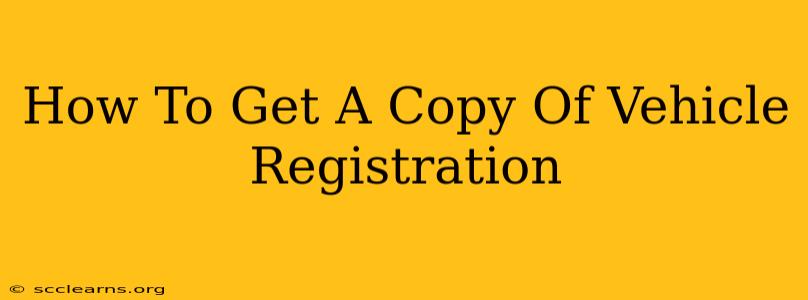Losing your vehicle registration can be a stressful experience, leaving you vulnerable to fines and inconveniences. Fortunately, obtaining a replacement is usually straightforward. This guide outlines the various methods for getting a copy of your vehicle registration, regardless of your location or circumstances.
Understanding Your Vehicle Registration
Before diving into the process, it's crucial to understand what your vehicle registration is and why it's so important. Your registration document, also known as a vehicle title or registration certificate, proves legal ownership of your vehicle. It contains vital information such as:
- Vehicle Identification Number (VIN): A unique identifier for your car.
- License Plate Number: The number displayed on your vehicle's license plates.
- Owner's Name and Address: Your details as the registered owner.
- Vehicle Make, Model, and Year: Specifications of your vehicle.
- Registration Expiration Date: The date your registration needs to be renewed.
Methods to Obtain a Replacement Vehicle Registration
The process for obtaining a replacement vehicle registration varies depending on your location (state/province/country). However, the most common methods include:
1. Online Renewal/Replacement: The Easiest Option
Many DMV (Department of Motor Vehicles) or equivalent agencies now offer online services. This is often the quickest and most convenient method. You'll typically need your:
- Vehicle Identification Number (VIN)
- License Plate Number
- Driver's License Number
- Possibly your previous registration number
Check your state's DMV website for online services. The specific requirements will vary depending on your location. Be sure to verify the legitimacy of the website before submitting any personal information.
2. Visiting Your Local DMV Office: The Traditional Approach
If online services aren't available or you prefer in-person assistance, visiting your local DMV office is another option. You'll need to bring specific documents, which might include:
- Proof of Identity (Driver's License or Passport)
- Proof of Vehicle Ownership (previous registration, if available)
- Vehicle Identification Number (VIN)
Expect potential wait times, especially during peak hours. Contact your DMV beforehand to inquire about required documents and estimated wait times. This will help streamline your visit.
3. Mailing a Request: A Slower but Reliable Method
Some DMV offices allow you to request a replacement registration via mail. This usually involves filling out a specific form (often available online), providing the necessary information (including your VIN and driver's license number), and paying the required fee. This method usually takes longer than online or in-person requests.
4. Contacting Your Insurance Provider (In Certain Cases)
In some instances, your insurance provider might have a record of your vehicle registration. While this isn't a guaranteed method, it's worth contacting them to inquire if they can provide a copy or direct you to the correct resources.
Important Considerations:
- Fees: Expect to pay a fee for a replacement registration. The cost varies by location.
- Processing Time: The time it takes to receive your replacement registration will differ depending on the method chosen. Online applications are generally the fastest.
- Lost or Stolen Registration: If your registration was stolen, report it to the authorities immediately. This will protect you from potential identity theft and fraud.
Finding Your State/Province's DMV Website:
The easiest way to begin is by searching "[Your State/Province] DMV" on a search engine. This should direct you to the official website with information about replacing lost registrations.
By following these steps, you can efficiently obtain a replacement copy of your vehicle registration, ensuring you stay compliant with local regulations and avoid potential penalties. Remember to always verify information and use official channels to prevent scams.

